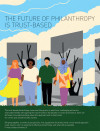 (Illustration by Andrea Mongia)
(Illustration by Andrea Mongia)
Over the years, funders would tell those of us at the Hill-Snowdon Foundation, “You’re such an example.” They were so proud of our organizing work, especially in the US South. They pointed to how we centered our relationships with our partners and how we focused on racial justice as underlying and informing every issue. These acknowledgments could have served as a signal that we were doing enough, causing us to stop interrogating our own behaviors.
The Future of Philanthropy Is Trust-Based

The trust-based philanthropy movement has grown in rapid time, but there are still basic misunderstandings about this approach and its bold vision for a more just and democratic society. This supplement illustrates what a trust-based approach really means, why it is essential to effective philanthropy, and what will be possible if more funders embrace it. Sponsored by the Trust-Based Philanthropy Project
But we did not stop. Instead, we uncovered gaps in our approach and outdated practices that did not align with our values. Like so many in philanthropy, we relied on old habits, having inherited certain practices without taking time to critique them. A new philosophy that aligned with trust-based philanthropy helped us realize that our commitment to centering racial justice and power building required us to change.
Together, we offer our combined reflections on that process as executive director and board president of the Hill-Snowdon Foundation. We share the following road map for other funders who are committed to advancing justice but may feel stuck using conventional practices that cause more harm than good.
Stop Ambivalent No’s
Our need for change came into sharp focus in 2020. Funders that had long accepted status quo philanthropy began to shift when faced with the unprecedented needs of communities amid the pandemic, racial justice uprisings, and political upheaval.
In the spring of that year, the Hill-Snowdon staff had many calls with our partners to hear what the foundation could do to better support them. At the end of one call, one of our longtime partners, the Black Organizing Project, inquired if the foundation could begin multiyear grantmaking.
Until that point, Hill-Snowdon had only provided long-term grants on an annual basis. To us, longer or shorter grant periods were a technicality; our commitment was the same. However, for our community partners, who had asked us to shift to multiyear grants during our 2005 strategic planning process, longer-term grants brought stability to their work.
Yet we had failed to grasp this truth—not because of a strategic disagreement but simply, we realized, because of habit: Multiyear grants would have required changes to our accounting practices. The shift from one year to multiple was tedious and technical, which at the time was enough of a barrier to stop us changing.
Fifteen years later and in the context of crisis and turmoil, our “ no” to the request for multiyear funding felt wrong. It served our own interests, not our community partners’.
Reorienting to Service
Our shift from single-year grants to multiyear funding opened other questions and possibilities. We called this our strategic reorientation: We reoriented ourselves from supporting our partners to serving them, by not only moving the foundation’s grant dollars to our community partners but also doing it in a way that fully and deliberately aligned with our values.
This service reorientation gave us a different lens for examining our work. We began to ask ourselves, “How is this serving our partners?” When the answer was that it wasn’t, we then asked what must change so that it did. For example, staff members previously spent hundreds of hours creating long and detailed write-ups for our board dockets. When we realized that this wasn’t serving our partners, we eliminated these time-consuming write-ups, which created time for staff to connect with community partners to learn more about how to better serve them.
The Conditions for Change
Among many elements that helped the Hill-Snowdon Foundation introduce these changes was the clarity of our values around power and racial justice. Building trusting relationships with our partners had always mattered to us and was central to Nat Chioke Williams’ experience as a community and youth organizer. We were committed to investing directly in and following the lead of marginalized individuals working to create a new system that benefited everyone.
Hill-Snowdon’s racial justice orientation made it possible to explore the changes we incorporated into our organization. Trust-based philanthropy gave us the language to understand that while we were clear on our values, our commitment to relationships was not being reflected in our grantmaking practices. With changes like embracing multiyear grants and doing away with lengthy dockets, we saw our organization’s actions more closely reflect our words. As we moved into our strategic reorientation, we learned four lessons, which we hope will inspire other foundation board and staff members seeking to strengthen their own racial justice and trust-based orientations:
Consider the changes your board needs. | One of Williams’ primary roles is to foster relationships between the board and the community. This is done through site visits and other opportunities that ground racial justice issues in personal experience and connection. By making this an explicit part of his role, Williams built trust, eventually paving the way to expanding the board to include trustees beyond just family members.
In 2020, three non-family community trustees—leaders of color who are experts in their fields—joined the board. Recruiting, selecting, and onboarding new trustees took a great deal of care and contemplation. We pushed ourselves to understand how to create a multiracial space from a monoracial one. We also redefined our board’s role in order to increase support for Black-led organizing.
Additionally, in November 2022, the Hill-Snowdon board decided to relinquish some of its decision-making power. In that meeting, we voted to move to multiyear general operating support grants and to transfer decision-making for all grants up to $100,000 to our staff.
Deepen internal racial justice work. | Hill-Snowdon was not new to racial justice and equity grantmaking. But we realized that becoming fully committed to anti-racism as an organization required exploring what it means to have a predominantly white board investing in Black-led organizing. It was not enough to rely on aligned grantmaking or to invite the board to build alliances with our community partners. We also examined our identities in relation to the work, including the biases we bring.
While we already had the desire to engage in this work, we did not have the structure and support for reflection and learning. Hill-Snowdon hired a racial equity consultant to embark on this journey with family members on the board, year over year. The process included having deep conversations about the family’s intersections with racism and examining their sources of wealth.
Invest in building trust internally. | We strive for nonhierarchical dynamics and relationships. For example, any staff member may attend any board committee meeting. We also respect the expertise, experience, and knowledge of each person on the team. Liz Bonner, a family trustee, has full faith in Williams as the expert in grantmaking and the person who has deep relationships with grassroots partners and other funders. It may sound simplistic, but sharing each person’s contributions and working together for so many years have cultivated mutual trust and respect.
In 2014, when Michael Brown was killed by police in Ferguson, Missouri, and BLM was gaining mainstream visibility, Williams wrote an article called “Making Black Lives Matter,” about philanthropy’s role in investing in Black-led social change. As executive director, Williams informed the board that the article would be published under the Hill-Snowdon Foundation’s name, rather than asking for their permission. The entire board endorsed his decision because they fully supported his leadership—a level of affirmation reflecting their relationship rooted in trust, shared values, and a shared commitment.
Start with power. | If our goal is to redistribute power toward a more equitable future, we must begin by identifying how and where power exists in our work and processes. From there, funders can begin making intentional shifts toward a greater goal.
When Hill-Snowdon began updating our approach, we got organized by creating a map of the changes under our new model. With every interrogation of a process came change. All the elements in our work were connected, requiring us to stay deliberate and flexible. For example, when we removed our board dockets, we had to rethink board meetings and staff roles so that we could continue to share high-level learnings with the board. We discovered that 100 elements had to change.
Vigilance Is the Only Victory
How, in this moment, can there be racial-justice funders who do not adhere to trust-based principles? How are we still witnessing funders who voice their commitment to social justice while missing the chance to truly serve their partners?
When we understand that this work is about breaking down hierarchies and restructuring relationships, we realize, as Williams says, that vigilance is the only victory. Who we are and how we show up is a perpetual experience. There is no finish line. You cannot have a just society without trusting in the humanity of all people.
In recent years, we have seen some funders change the window dressing of their grantmaking to resemble trust-based practices. But trust-based philanthropy is deeper than a shift to multiyear grantmaking or simplifying grant applications. If we stop being vigilant about making racial justice and trust the foundation of our work, we risk replicating the very dynamics that define our unequal society. Vigilance is especially important if we understand philanthropy as a direct product of racialized power in this country. If we can change relationships in our sector, imagine the potential for change on an even broader scale.
Support SSIR’s coverage of cross-sector solutions to global challenges.
Help us further the reach of innovative ideas. Donate today.
Read more stories by Nat Chioke Williams & Liz Bonner.

